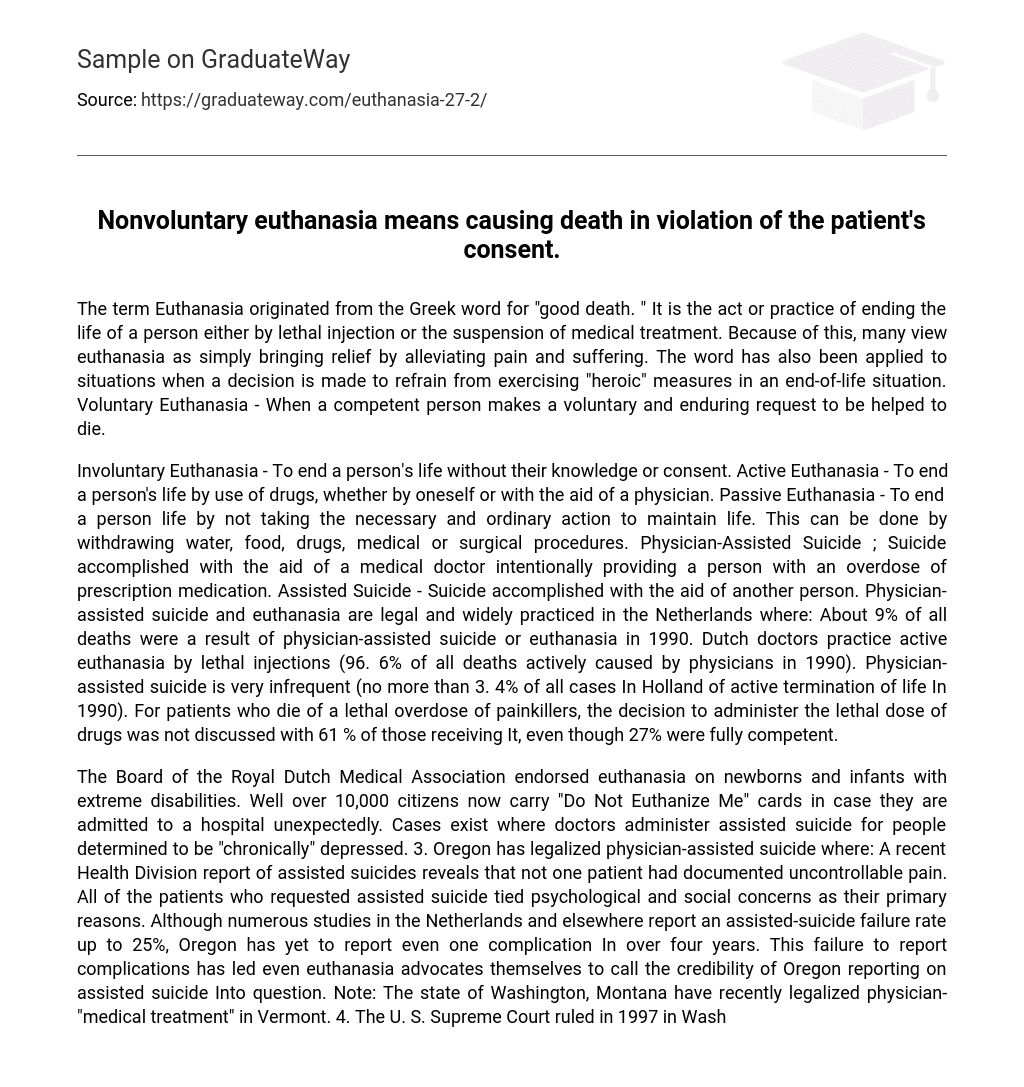The term Euthanasia originated from the Greek word for “good death. ” It is the act or practice of ending the life of a person either by lethal injection or the suspension of medical treatment. Because of this, many view euthanasia as simply bringing relief by alleviating pain and suffering. The word has also been applied to situations when a decision is made to refrain from exercising “heroic” measures in an end-of-life situation. Voluntary Euthanasia – When a competent person makes a voluntary and enduring request to be helped to die.
Involuntary Euthanasia – To end a person’s life without their knowledge or consent. Active Euthanasia – To end a person’s life by use of drugs, whether by oneself or with the aid of a physician. Passive Euthanasia – To end a person life by not taking the necessary and ordinary action to maintain life. This can be done by withdrawing water, food, drugs, medical or surgical procedures. Physician-Assisted Suicide ; Suicide accomplished with the aid of a medical doctor intentionally providing a person with an overdose of prescription medication. Assisted Suicide – Suicide accomplished with the aid of another person. Physician- assisted suicide and euthanasia are legal and widely practiced in the Netherlands where: About 9% of all deaths were a result of physician-assisted suicide or euthanasia in 1990. Dutch doctors practice active euthanasia by lethal injections (96. 6% of all deaths actively caused by physicians in 1990). Physician-assisted suicide is very infrequent (no more than 3. 4% of all cases In Holland of active termination of life In 1990). For patients who die of a lethal overdose of painkillers, the decision to administer the lethal dose of drugs was not discussed with 61 % of those receiving It, even though 27% were fully competent.
The Board of the Royal Dutch Medical Association endorsed euthanasia on newborns and infants with extreme disabilities. Well over 10,000 citizens now carry “Do Not Euthanize Me” cards in case they are admitted to a hospital unexpectedly. Cases exist where doctors administer assisted suicide for people determined to be “chronically” depressed. 3. Oregon has legalized physician-assisted suicide where: A recent Health Division report of assisted suicides reveals that not one patient had documented uncontrollable pain. All of the patients who requested assisted suicide tied psychological and social concerns as their primary reasons. Although numerous studies in the Netherlands and elsewhere report an assisted-suicide failure rate up to 25%, Oregon has yet to report even one complication In over four years. This failure to report complications has led even euthanasia advocates themselves to call the credibility of Oregon reporting on assisted suicide Into question. Note: The state of Washington, Montana have recently legalized physician- “medical treatment” in Vermont. 4. The U. S. Supreme Court ruled in 1997 in Washington v. Gloucester that there is no federal constitutional substantive right to assisted suicide.
In a 1997 companion case, the U. S. Supreme Court ruled in Vocal v. Quill that there is no federal constitutional equal protection right to assisted suicide. 5. Virtually every established medical and nursing organization in the United States declares physician-assisted suicide is unethical. 6. There are no laws, medical associations, church denominations, or right-to-life groups who insist that unnecessary, heroic, or truly futile treatments be provided to prolong life and all recognize the right of competent patients to refuse medical treatment. 7. 5% of anger pain is controllable and the remaining 5% can be reduced to a tolerable level. 8. The states of California,





